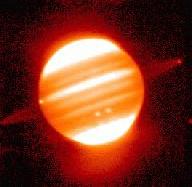Basic Characteristics of our Solar System, Part Deux
3) Everything we can possibly age (meteorites, Earth, Moon, Mars and the Sun) has the same age, 4.5 b.y.o.
4) Planets are well spaced out, even Neptune and Pluto are well timed not to hit.
5) Composition of planets is related to their distance from Sun:
-
Terrestrial Planets: Mercury, Venus, Earth & Mars are solid rocks with
very thin (or no) atmosphere.
Jovian (gas giant) Planets: Jupiter, Saturn, Uranus, Neptune are enormous thick atmosphered planets, with possible solid cores.
Pluto Small, icy rock, like other objects found at that distance.
6) Chemical composition matches the Sun's, especially Jupiter & Saturn. Uranus & Neptune are colder, with molecules (water, CO2, methane, ammonia). Meteorites match Sun's composition of everything except H, He, which escaped into space.
 7) Planetary Satellites are common for big planets.
Of the Terrestrial planets, only Earth has a real moon. Mars'
Deimos and Phobos (only 10 km radii) are stolen asteroids!
All Jovian planets have rings (not JUST Saturn).
7) Planetary Satellites are common for big planets.
Of the Terrestrial planets, only Earth has a real moon. Mars'
Deimos and Phobos (only 10 km radii) are stolen asteroids!
All Jovian planets have rings (not JUST Saturn).
8) The Oort Cloud. A spherical `cloud' of icy comets surrounding our Solar System with a radius of 10,000 to 100,000 AU (earth-sun distances). This is based on orbital properties of the hundreds of comets. These comets can come from any direction and orbit the Sun in any direction.
9) The Kuiper Belt. A flattened, `cloud' of icy comets which rotate with the rest of the solar system. These comets are found from 30 to 50 AU. Dozens have been identified and Pluto's characteristics match objects found in the Kuiper Belt.
10) Sun contains 99.8% of Solar System mass, most of the rest is in Jupiter. The planets, particularly Jupiter, contain most of the Solar System angular momentum.
11) Meteorites tell us the Solar System was once at 1500 K, and that the material evolved from a cloud into solid grains in just 10 million years.